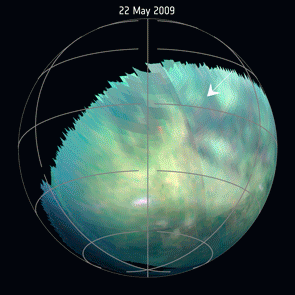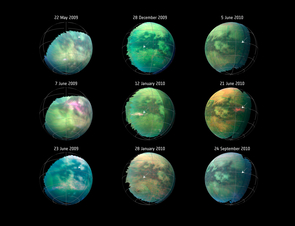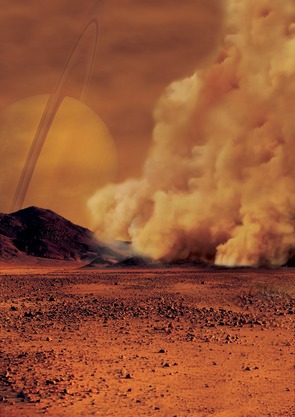Dust storms on Titan spotted by Cassini for the first time
24 September 2018
Data from the international Cassini spacecraft that explored Saturn and its moons between 2004 and 2017 has revealed what appear to be giant dust storms in equatorial regions of Titan. |
| Spotting dust storms on Titan. Credit: NASA/JPL-Caltech/University of Arizona/University Paris Diderot/IPGP/S. Rodriguez et al. 2018 |
The discovery, described in a paper published in Nature Geoscience today, makes Titan the third body in the Solar System where dust storms have been observed – the other two are Earth and Mars.
The observation is helping scientists to better understand the fascinating and dynamic environment of Saturn's largest moon.
"Titan is a very active moon," says Sébastien Rodriguez, an astronomer at the University Paris Diderot, France, and the lead author of the paper.
"We already know that about its geology and exotic hydrocarbon cycle. Now we can add another analogy with Earth and Mars: the active dust cycle."
Complex organic molecules, which result from the atmospheric chemistry and, once large enough, eventually fall to the surface, can be raised from large dune fields around Titan's equator.
Titan is an intriguing world – in a way quite similar to Earth. In fact, it is the only moon of the Solar System with a substantial atmosphere and the only celestial body other than our planet where stable bodies of surface liquid are known to still exist.
There is one big difference though: while on Earth such rivers, lakes and seas are filled with water, on Titan it is primarily methane and ethane that flows through these liquid reservoirs. In this unique methane cycle, the hydrocarbon molecules evaporate, condense into clouds and rain back onto the ground.
The weather on Titan varies from season to season, just as it does on Earth. In particular around the equinox, the time when the Sun crosses Titan's equator, massive clouds can form in tropical regions and cause powerful methane storms. Cassini observed such storms during several of its Titan flybys.
 |
| The three dust storms spotted on Titan. Credit: NASA/JPL-Caltech/University of Arizona/University Paris Diderot/IPGP/S. Rodriguez et al. 2018 |
When Sébastien and his team first spotted three unusual equatorial brightenings in infrared images taken by Cassini around the moon's 2009 northern equinox, they thought these might be exactly such methane clouds. A thorough investigation revealed they were something completely different, however.
"From what we know about cloud formation on Titan, we can say that such methane clouds in this area and in this time of the year are not physically possible," says Sébastien. "The convective methane clouds that can develop in this area and during this period of time would contain huge droplets and must be at a very high altitude, much higher than the 10 km that modelling tells us the new features are located."
The researchers were also able to rule out that the features were actually on the surface in the form of frozen methane rain or icy lavas. Such surface spots would have a different chemical signature and remain visible for much longer, while the bright features in this study were only visible for 11 hours to five weeks.
Modelling also showed that the features must be atmospheric, but still close to the surface – most likely forming a very thin layer of tiny solid organic particles. Since they were located right over the dune fields around Titan's equator, the only remaining explanation was that the spots were actually clouds of dust raised from the dunes.
 |
| Artist's impression of a dust storm on Titan. Credit: IPGP/Labex UnivEarthS/University Paris Diderot – C. Epitalon & S. Rodriguez |
Sébastien says that while this is the first ever observation of a dust storm on Titan, the finding is not surprising.
"We believe that the Huygens probe, which landed on the surface of Titan in January 2005, raised a small amount of organic dust upon arrival due to its powerful aerodynamic wake," says Sébastien. "But what we spotted here with Cassini is at a much larger scale. The near-surface wind speeds required to raise such an amount of dust as we see in these dust storms would have to be very strong – about five times as strong as the average wind speeds estimated by the Huygens measurements near the surface and with climate models."
Huygens made only one direct measurement of the speed of the surface wind just before its landing on Titan, and at that time it was very low, less than 1 metre per second.
"For the moment, the only satisfactory explanation for these strong surface winds is that they might be related to the powerful gusts that may arise in front of the huge methane storms we observe in that area and season," concludes Sébastien.
This phenomenon, called 'haboob', can also be observed on Earth with giant dust clouds preceding storms in arid areas.
The existence of such strong winds generating massive dust storms also implies that the underlying sand can be set in motion, too, and that the giant dunes covering Titan's equatorial regions are still active and continually changing.
The winds could be transporting the dust raised from the dunes across large distances, contributing to the global cycle of organic dust on Titan, and causing similar effects to those that can be observed on Earth and Mars.
Notes for editors
"Observational evidence for active dust storms on Titan at equinox," by S. Rodriguez et al. is published in Nature Geoscience. DOI: 10.1038/s41561-018-0233-2
The results were obtained with Cassini's Visual and Infrared Mapping Spectrometer.
The Cassini-Huygens mission is a cooperative project of NASA, ESA and the Italian Space Agency.
For more information please contact:
Sébastien Rodriguez
University Paris Diderot, France
Planetary and Space Science Group, Institut de Physique du Globe de Paris (IPGP)
Email: rodriguez![]() ipgp.fr
ipgp.fr
Nicolas Altobelli
ESA Cassini-Huygens Project Scientist
Tel: +34 91 813 1201
Email: nicolas.altobelli![]() esa.int
esa.int
Markus Bauer
ESA Science Communication Officer
Tel: +31 71 565 6799
Mob: +31 61 594 3 954
Email: markus.bauer![]() esa.int
esa.int



